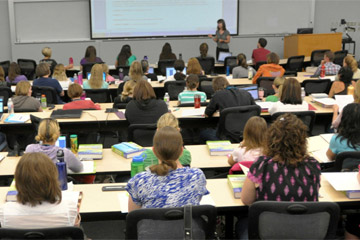
By Dan Meyers | University Communications
AURORA, Colo. - Safety and quality seem like obvious goals for health care education. But improving the way budding doctors and nurses are taught, bringing those professions together in the classroom and clinical settings, and measuring the results, turns out to be a challenge.
That’s the conclusion of a new study that reviews an initiative called Retooling for Quality and Safety, sponsored by the Josiah Macy Jr. Foundation and the Institute for Healthcare Improvement.
The study’s authors include the University of Colorado’s Amy Barton, PhD, RN, and Wendy Madigosky, MD, representing two of the health profession schools on the university’s Anschutz Medical Campus.
It was hard to find enough teachers or the right mix of students from different health care professions, the study says. Beyond that, it was difficult to show that the changes mattered “to connect education innovations to demonstrable improvements in patient care.”
The retooling initiative involved six universities including CU in the 2009-10 academic year. It supported new learning activities, most of which involved medical and nursing students.
“Our research represents some of the tough initial work in this effort,” says Madigosky, an associate professor of family medicine at the CU School of Medicine.
“While these findings are an important start, there is more work and evaluation to come,” adds Barton, an associate dean for clinical and community affairs at the University of Colorado College of Nursing.
Professional organizations representing medicine, nursing, pharmacy, dentistry and public health recently began a formal collaboration to identify the core skills needed in health care and to incorporate them into health professions education. The emphasis on quality, especially through interprofessional education, has been growing in healthcare and has been a priority at CU.
The CU School of Dental Medicine recently was given the Outstanding Innovation Award by the Academic Dental Education Association for its support of interprofessional education courses.
In their paper, published in Health Affairs, Barton, Madigosky and their co-authors set out to evaluate how the first steps of the retooling project had gone.
They found that the six participating schools did a good job of bringing interprofessional education into the curriculum. But they also discovered that there was a “lack of critical mass” of faculty members ready to teach about improving care.
Also, it was hard to figure out of the programs were working or – the ultimate goal -- benefitting patients.
“The paucity of robust evaluation strategies for such programs suggests a future research agenda that deserves to be funded,” the Health Affairs paper says.
###
Contact: Dan.Meyers@ucdenver.edu
